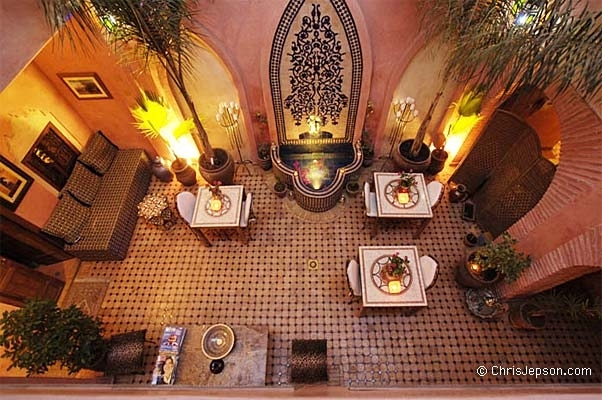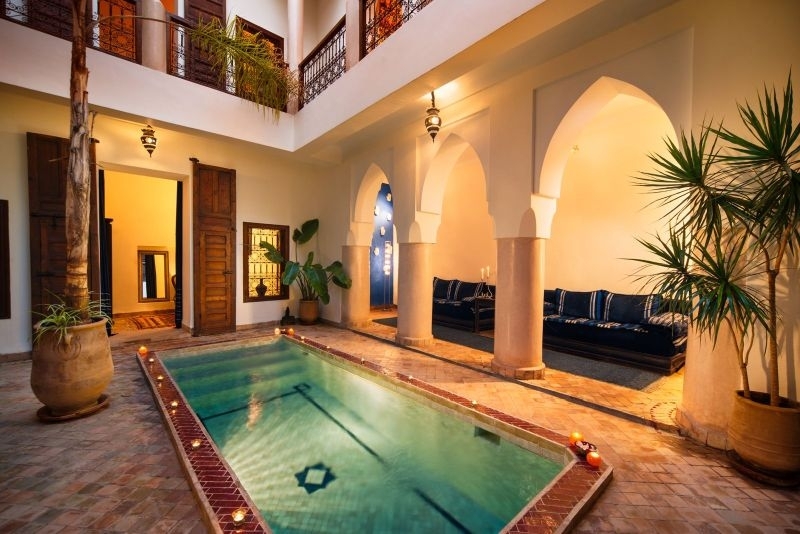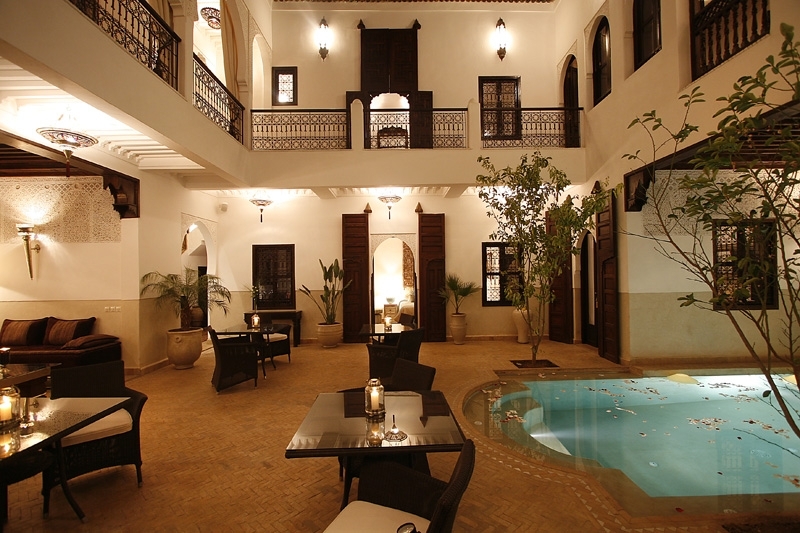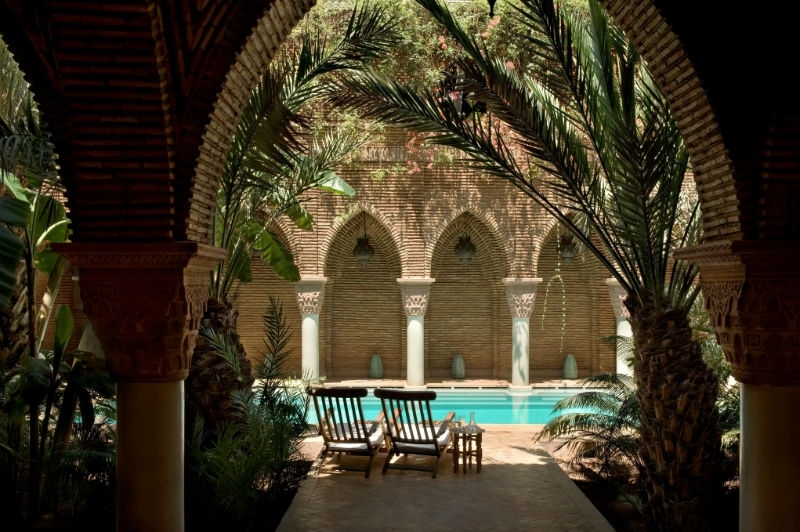Iftar in Marrakech
July 24th, 2014

The Iftar, taken from the Arabic Ű„Ù۷ۧ۱â, which literally translates as âBreakfastâ, refers to the evening meal when Muslims end their fast during Ramadan. In Morocco, as elsewhere, it is traditional for people to try and break their fast at home, with their families. Therefore in the moments leading up to Iftar there is a rush of activity as locals close their shops, finish their work and rush home in time to break fast. The moment after the call to prayer rings out, there is a rare moments of serene silence that falls over Marrakech: the usually bursting streets are empty; although never empty, the Jemaa el-Fna takes on an eerie silence; and a lot of the shops close.
However, the silence does not last for long; within half an hour the local Marrakchis flood back on the streets to work, rest and play. Everything returns to normal; Marrakech is alive again.
Tags: holiday in morocco, Iftar, islam, local marrakech, maroc, Marrakech, Marrakech culture, Marrakech history, marrakech mentality, Marrakech mosque, marrakech riad, morocco, morocco culture, Ramadan, Travel in Morocco, visit marrakech, visit morocco
Posted in Marrakech, Photo a day | Comments Off on Iftar in Marrakech
The Watermelons of Marrakech
July 22nd, 2014
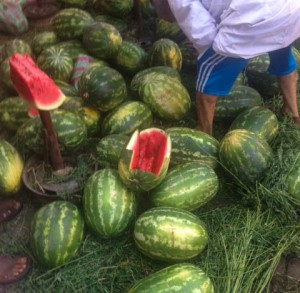
Watermelons are thought to have originated in southern Africa, where it is often found growing wild. Of course, today the watermelon is enjoyed all over the world and is often associated with warm climates and hot weather. It is not surprising then that Morocco is the world’s 12th melon exporter in the world. Indeed, melon production is covers a huge 12,000 hectors across the whole of Morocco and is produced around Marrakech in the towns of Shichawa and Klaa de Sraghn.
It is easy to find Watermelon at all times of year at very reasonable prices, especially in the Summer where they offer a refreshing treat from the sun. If you are lucky, you might even be able to wait until after the Souks close to try and a find a free melon as the stallholder gives often away his old products when the day is up.
Tags: african fruit, food, food travel, fruit, Marrakech, melon, summer, travel, watermelon
Posted in Marrakech, Photo a day | Comments Off on The Watermelons of Marrakech
The Minaretâs of Marrakech
July 15th, 2014
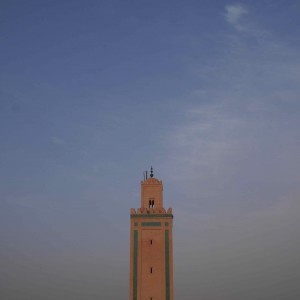
The city of Marrakech contains more than 360 mosques and, of course, the visual focal point of each mosque is the minaret. The minaret – from the arabic manÄra (Ù
Ùۧ۱۩), meaning lighthouse – is a tall spire or tower that extends up from the main mosque. Perhaps the most prominent example is the beautiful minaret of the Koutoubia mosque, Marrakechâs oldest and biggest mosque, which looks over the famous Jemaa el-Fna square and can be be seen from right across the city, rising almost 70m.
The main function of the minaret is to provide a vantage point from which the call to prayer is made and once you enter Marrakech it is impossible not to hear this enchanting call ring out across the city 5 times a day; perhaps if you arrive in Marrakech by night, this call will provide your wake up alarm? Minarets also function as air conditioning mechanisms: as the sun heats the dome of the Mosque, air is drawn in through open windows then up and out of the minaret, thus providing ventilation. Due to Islamic law, non-muslims canât visit the mosque but the tourist can admire the beauty of the minarets as they wander through the red city.
Tags: islam, koutoubia, Marrakech mosque, medina, minaret, mosque
Posted in Marrakech, Photo a day | Comments Off on The Minaretâs of Marrakech
Marrakech Reading List: ‘A Street in Marrakech’ by Elizabeth Warnock Fernea
July 13th, 2014
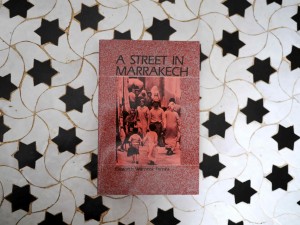
Elizabeth Warnock Fernea and her family moved into a small street in the Medina or the traditional city of Marrakech in August 1971, when her husband received a grant to study Moroccan culture. Her book, a ‘Street in Marrakech’, provides a personal view of the city as experienced from her eyes and is just and as insightful as any anthropological study: Fernea’s descriptive account depicts her families acclimatization to Marrakech’s climate and culture and their gradual acceptance into the community.
This is a brilliantly entertaining and insightful book that perfectly captures the rhythm and spirit of life in the backways of the Medina during the 70s. Indeed, over 40 years later, this book still provides a good introduction to Marrakech. The prevalent consciousness of notable landmarks and real street-names that are embedded in the pages construct an accurate portrait of such a rich and vibrant city.
Tags: books, books about marrakech, marrakech book, Marrakech Reading List, marrakesh books, travel book
Posted in Marrakech | Comments Off on Marrakech Reading List: ‘A Street in Marrakech’ by Elizabeth Warnock Fernea
Ras el Hanout
July 12th, 2014
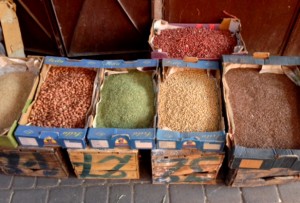
Morocco cuisine is known throughout the world for itâs extensive use of spices. Perhaps the most prevelant in Moroccan cooking is Ras el Hanout, a mixture of ground spices that literally translates as âthe head of the shopâ, implying that the spice provides the best the shop has to offer. The recipe for Ras el Hanout varies from region to region, and even from shop to shop; but they frequently include cardamom, nutmeg, anise, mace, cinnamon, ginger, various peppers, and turmeric.
Once upon a time, Ras el Hanout included cantharides, a substance excreted form the Spanish flyâs leg joints. However the sale of cantharides was banned in Morocco during the 1990s due to itâs suspected aphrodisiac qualities. Here at Hip Marrakech, we think Ras el Hanout tastes great without cantharides and we are pretty glad of this modern recipe change.
Tags: Marrakech, Moroccan food, moroccan spices, spice
Posted in Marrakech | Comments Off on Ras el Hanout
Marrakech Reading List: ‘A Year in Marrakesh’ by Peter Mayne
July 10th, 2014
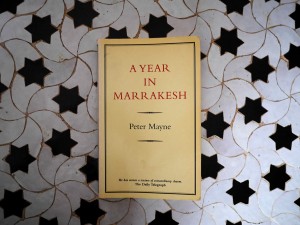
If you are looking for a good book to accompany you on your trip to Marrakech, or if you are simply looking to learn more about Moroccan culture then look no further. Our Marrakech Reading List kicks off with Peter Mayne’s ‘A Year in Marrakesh’, a personal record of an English man’s attempt to settle in Marrakech during the 1950’s.
Mayne’s account gives you a glimpse of Marrakech before it became a tourist destination. Yet, while you may not see a mention of the tourist spots or cultural monuments like the Cafe de France or Jemaa el-Fna, this book often provides a clearer view of Marrakech than your average tourist guide. Tinged with an ounce of wit and humor, Mayne depicts Marrakech exactly as he sees it. However he does without claiming that his opinions and deductions can be mistaken for absolute facts. Therefore whilst reading his simple, journalistic style it is almost impossible not become fully immersed in the vibrant bustle and dry heat of Marrakech; and yet there still remains a space for uncertainty and adventure as we follow Mayne in his efforts to understand such a beautiful and perplexing city.
Tags: book, marrakech book, marrakesh book, reading list, story, travel book
Posted in Marrakech, Reading and Literature | Comments Off on Marrakech Reading List: ‘A Year in Marrakesh’ by Peter Mayne
The Seasonal Jobs of Ramadan
July 8th, 2014
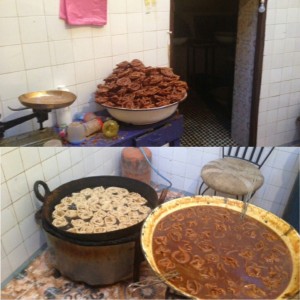
During the month of Ramadan, many Moroccanâs change their job to fit the alternate rhythm of life during this period. As the Muslim people fast during the day, the small shops and many of the non-tourist restaurants which sell food and drink to locals need to find a way to make money.
Abdil invited us into his shop to explain that, where he normally sold a selection of nuts and dried fruits, during Ramadan he switches to sell Chapakia, a sweet Moroccan patisserie. Chapakia costs around 30dh per kg and is especially popular during ramadan as itâs sugary sweetness provides a much needed energy boost after 17 hours of fasting. He continued to tell us that some locals make Chapakia at home, but the majority of people like to buy the sweet patisserie from specialist shops as he and many other like him have perfected the skill of making such a delicacy. Other products that are especially popular during this Ramadan seasonal change are figs, if Ramadan occurs during the summer month, and dates, which are an important ingredient for the Moroccan soup, Harira. These seasonal changes are testament to the vibrancy and vitality of Marrakech and the uniquely fascinating tradition of Ramadan.
Tags: Chapakia, food, islam, Marrakech, Moroccan patisserie, Ramadan, religion
Posted in Marrakech, Photo a day | Comments Off on The Seasonal Jobs of Ramadan
100 years of Moroccan trains, 50 years of The National Office of Railways (ONCF)
July 3rd, 2014
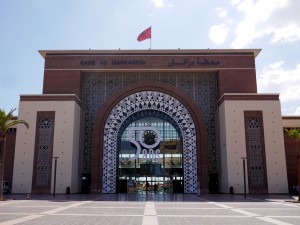
100 hundred years ago the first train line was built in Morocco. It connected the cities of Casablanca and Berrechid and was used to transport supply military troops of the French Protectorate. Fast forward almost exactly 50 years and The National Office of Railways – or the ONCF as it is now more commonly known –Â is born as a state owned company. Fast forward another 50 years to the present day and the stylish Marrakech Train station located in the New Town of Guilez is commemorating the ONCFâs 50th birthday by proudly wearing an equally stylish anniversary logo.
This dual commemoration of both the first train line in Morocco and the ONCF is interesting in many ways. For one, to study the history of the Moroccan rail system is to trace the socio-economic history of the country from former French colony through independence towards todays generation. Secondly, because we are poised on the eve of a new era: the ONCF is about to put the first high-speed train on the Africa continent and in the Arab world.So, the popularity of the train continues to grow and the service is increasingly used by industry, Moroccans and tourists alike. Perhaps the rail system and the Marrakech train station will provide your entrance into Marrakech? Or perhaps it will function as portal towards your next adventure in Morocco or beyond? Either way, it is clear to see that the Moroccan rail system is on the right track.
Tags: 50 years, anniversary, Marrakech, marrakech train, Marrakech train station, marrakech travel, Marrakesh gare
Posted in Marrakech, Photo a day | Comments Off on 100 years of Moroccan trains, 50 years of The National Office of Railways (ONCF)
The Last Storytellers of Morocco
May 1st, 2014
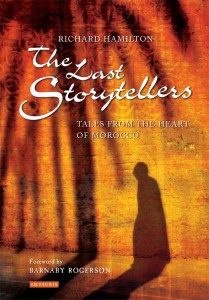 Essential reading for visitors to Marrakech! The Last Storytellers is a wonderful new collection of traditional tales from the city that will help visitors understand the culture and mystery of Morocco. Marrakech is the heart and lifeblood of Morocco’s ancient storytelling tradition. For nearly a thousand years, storytellers have gathered in the Jemaa el Fna, the legendary square of the city, to recount ancient folktales and fables to rapt audiences. But this unique chain of oral knowledge, that has passed from generation to generation, is now on the brink of extinction. Richard Hamilton has witnessed at first hand the death throes of this rich and captivating tradition and, in the labyrinth of the Marrakech medina, has tracked down the last few remaining storytellers, recording stories that are replete with the beauty of the Maghreb. The book is available in bookshops in the UK as well as Morocco. It is also on sale via Amazon in paperback, hardback and kindle. https://www.youtube.com/watch?v=GTV3_cpLZP4&list=PL_zq2VoQARsw8tY3QFf0ZskWxHOz5skRV
Essential reading for visitors to Marrakech! The Last Storytellers is a wonderful new collection of traditional tales from the city that will help visitors understand the culture and mystery of Morocco. Marrakech is the heart and lifeblood of Morocco’s ancient storytelling tradition. For nearly a thousand years, storytellers have gathered in the Jemaa el Fna, the legendary square of the city, to recount ancient folktales and fables to rapt audiences. But this unique chain of oral knowledge, that has passed from generation to generation, is now on the brink of extinction. Richard Hamilton has witnessed at first hand the death throes of this rich and captivating tradition and, in the labyrinth of the Marrakech medina, has tracked down the last few remaining storytellers, recording stories that are replete with the beauty of the Maghreb. The book is available in bookshops in the UK as well as Morocco. It is also on sale via Amazon in paperback, hardback and kindle. https://www.youtube.com/watch?v=GTV3_cpLZP4&list=PL_zq2VoQARsw8tY3QFf0ZskWxHOz5skRV
Tags: Marrakech culture, Marrakech history, Marrakech Medina, medina life, Moroccan art, moroccan culture
Posted in Marrakech, Reading and Literature | Comments Off on The Last Storytellers of Morocco
Flowers of Marrakech: city of colours
August 25th, 2013
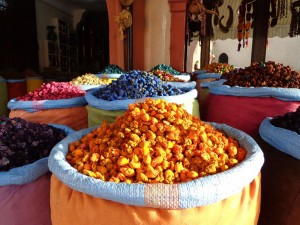
Though the ancient city of Marrakech has gained its nickname as the ‘red city’ because of the intense shade of red that is used to colour many of the residences here, don’t think that the city can be easily defined by this one colour. As you wander the winding streets of Marrakech sights such as these hand painted flower heads are commonplace. Locals collect the flowers and decorate them in striking shades of colour. After they are placed in bottles to bring life to the homes, stalls and shops. Overload your senses with the sights, smells and sounds of Marrakech whilst enjoying all the personal characteristics that a hotel Riad can offer you.Â
Tags: Marrakech colours, Marrakech decorations, marrakech riad, Moroccan art, Moroccan colours, moroccan culture, Moroccan decorations, Moroccan design, Moroccan flowers, The red city of Marrakech, visit marrakech, visit morocco
Posted in Marrakech, Photo a day | No Comments »

